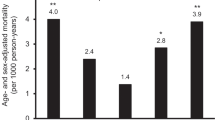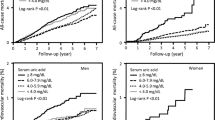Abstract
The role of serum uric acid as a predictor of stroke among the general Japanese population remains controversial. We conducted a prospective cohort study of 5235 men and 8185 women aged 40–79 years at baseline between 1985 and 1994 in four Japanese communities, who were initially free from stroke, coronary heart disease, and medication for hyperuricemia or gout. Cox proportional hazards models were used to estimate sex-specific hazard ratios of stroke and its types in relation to serum uric acid level. During a median follow-up of 23.1 years, we recorded 1018 (488 men and 530 women) incident strokes, including 222 (99 and 123) intraparenchymal hemorrhages, 113 (33 and 80) subarachnoid hemorrhages and 667 (347 and 320) ischemic strokes. After adjustment for age, community and known cardiovascular risk factors, the multivariable hazard ratios (95% CIs) in the highest vs. lowest quintile of serum uric acid were 1.45 (1.07–1.96) for total stroke, 1.20 (0.65–2.20) for intraparenchymal hemorrhage, 1.46 (0.69–3.09) for subarachnoid hemorrhage and 1.61 (1.07–2.41) for ischemic stroke in women. The corresponding multivariable hazard ratios (95% CIs) in men were 1.02 (0.74–1.35), 0.83 (0.40–1.72), 1.19 (0.38–3.75) and 1.00 (0.70–1.41). Furthermore, those positive associations with risks of total and ischemic strokes in women were more evident in nonusers of antihypertensive medication than the users. In conclusion, elevated serum uric acid level is an independent predictor of total stroke in women but not in men. The positive association in women was mostly attributable to ischemic stroke and was more pronounced among nonusers of antihypertensive medication.
This is a preview of subscription content, access via your institution
Access options
Subscribe to this journal
Receive 12 print issues and online access
$259.00 per year
only $21.58 per issue
Buy this article
- Purchase on Springer Link
- Instant access to full article PDF
Prices may be subject to local taxes which are calculated during checkout
Similar content being viewed by others
References
Wu AH, Gladden JD, Ahmed M, Ahmed A, Filippatos G. Relation of serum uric acid to cardiovascular disease. Int J Cardiol. 2016;213:4–7.
Borghi C, et al. Serum uric acid and the risk of cardiovascular and renal disease. J Hypertens. 2015;33:1729–41.
Feig DI, Kang DH, Johnson RJ. Uric acid and cardiovascular risk. N. Engl J Med. 2008;359:1811–21.
Perlstein TS, et al. Uric acid and the state of the intrarenal renin-angiotensin system in humans. Kidney Int. 2004;66:1465–70.
Mazzali M, et al. Elevated uric acid increases blood pressure in the rat by a novel crystal-independent mechanism. Hypertension. 2001;38:1101–6.
Lee SW, et al. Age-differential association between serum uric acid and incident hypertension. Hypertens Res. 2019;42:428–37.
Nieto FJ, Iribarren C, Gross MD, Comstock GW, Cutler RG. Uric acid and serum antioxidant capacity: a reaction to atherosclerosis? Atherosclerosis. 2000;148:131–9.
Zhong C, Zhong X, Xu T, Xu T, Zhang Y. Sex-specific relationship between serum uric acid and risk of stroke: a dose-response meta-analysis of prospective studies. J Am Heart Assoc. 2017;6:e005042.
Holme I, Aastveit AH, Hammar N, Jungner I, Walldius G. Uric acid and risk of myocardial infarction, stroke and congestive heart failure in 417,734 men and women in the Apolipoprotein MOrtality RISk study (AMORIS). J Intern Med. 2009;266:558–70.
Strasak A.VHM&PP Study Group. et al. Serum uric acid and risk of cardiovascular mortality: a prospective long-term study of 83,683 Austrian men. Clin Chem. 2008;54:273–84.
Strasak AM.VHM&PP Study Group. et al. Serum uric acid is an independent predictor for all major forms of cardiovascular death in 28,613 elderly women: a prospective 21-year follow-up study. Int J Cardiol. 2008;125:232–9.
Bos MJ, Koudstaal PJ, Hofman A, Witteman JC, Breteler MM. Uric acid is a risk factor for myocardial infarction and stroke: the Rotterdam Study. Stroke. 2006;37:1503–7.
Storhaug HM, et al. Uric acid is a risk factor for ischemic stroke and all-cause mortality in the general population: a gender specific analysis from The Tromsø Study. BMC Cardiovasc Disord. 2013;13:115.
Jimenez MC, Curhan GC, Choi HK, Forman JP, Rexrode KM. Plasma uric acid concentrations and risk of ischaemic stroke in women. Eur J Neurol. 2016;23:1158–64.
Hozawa A, et al. Serum uric acid and risk of ischemic stroke: the ARIC Study. Atherosclerosis. 2006;187:401–7.
Chien KL, et al. Hyperuricemia as a risk factor on cardiovascular events in Taiwan: the Chin‐Shan Community Cardiovascular Cohort Study. Atherosclerosis. 2005;183:147–55.
Kamei K, et al. Associations between serum uric acid levels and the incidence of nonfatal stroke: a nationwide community-based cohort study. Clin Exp Nephrol. 2017;21:497–503.
Sakata K, Hashimoto T, Ueshima H, Okayama A. NIPPON DATA 80 Research Group. Absence of an association between serum uric acid and mortality from cardiovascular disease: NIPPON DATA 80, 1980–1994. Eur J Epidemiol. 2001;17:461–8.
Zhang W, et al. EPOCH-JAPAN GROUP. Serum uric acid and mortality form cardiovascular disease: EPOCH-JAPAN Study. J Atheroscler Thromb. 2016;23:692–703.
Jee SH, Lee SY, Kim MT. Serum uric acid and risk of death from cancer, cardiovascular disease or all causes in men. Eur J Cardiovasc Prev Rehabil. 2004;11:185–91.
Choi HK, Soriano LC, Zhang Y, Rodríguez LA. Antihypertensive drugs and risk of incident gout among patients with hypertension: population based case-control study. BMJ. 2012;344:d8190.
Imano H, et al. Trends for blood pressure and its contribution to stroke incidence in the middle-aged Japanese population: the Circulatory Risk in Communities Study (CIRCS). Stroke. 2009;40:1571–7.
Yamagishi K, et al. The Circulatory Risk in Communities Study (CIRCS): a long-term epidemiological study for lifestyle-related disease among japanese men and women living in communities. J Epidemiol. 2019;29:83–91.
Iso H, Rexrode K, Hennekens CH, Manson JE. Application of computer tomography-oriented criteria for stroke subtype classification in a prospective study. Ann Epidemiol. 2000;10:81–87.
Coresh J, et al. Calibration and random variation of the serum creatinine assay as critical elements of using equations to estimate glomerular filtration rate. Am J Kidney Dis. 2002;39:920–9.
Nakamura M, et al. Total cholesterol performance of Abell-Levy-Brodie-Kendall reference measurement procedure: certification of Japanese in-vitro diagnostic assay manufacturers through CDC’s Cholesterol Reference Method Laboratory Network. Clin Chim Acta. 2015;445:127–32.
Nakamura M, et al. Comparison between the triglycerides standardization of routine methods used in Japan and the chromotropic acid reference measurement procedure used by the CDC Lipid Standardization Programme. Ann Clin Biochem. 2016;53:632–9.
Kirkendall WM, Feinlieb M, Freis ED, Mark AL. Recommendations for human blood pressure determination by sphygmomanometers. Subcommittee of the AHA Postgraduate Education Committee. Circulation. 1980;62:1146A–1155A.
Matsuo S, et al. Collaborators developing the Japanese equation for estimated GFR. Collaborators developing the Japanese equation for estimated GFR. Revised equations for estimated GFR from serum creatinine in Japan. Am J Kidney Dis. 2009;53:982–92.
Ozawa H. Fifty years history of new drugs in Japan: the developments and trends of antihypertensive drugs. Yakushigaku Zasshi. 2000;35:63–71. [Article in Japanese]
Shimodaira M, et al. Gender differences in the relationship between serum uric acid and mean platelet volume in a Japanese general population. Platelets. 2014;25:202–6.
Otani N, et al. Effects of uric acid on vascular endothelial function from bedside to bench. Hypertens Res. 2018;41:923–31.
Kanellis J, et al. Uric acid stimulates monocyte chemoattractant protein-1 production in vascular smooth muscle cells via mitogen-activated protein kinase and cyclooxygenase-2. Hypertension. 2003;41:1287–93.
Watanabe S, et al. Uric acid, hominoid evolution, and the pathogenesis of salt-sensitivity. Hypertension. 2002;40:355–60.
Feig DI, et al. Hypothesis: Uric acid, nephron number, and the pathogenesis of essential hypertension. Kidney Int. 2004;66:281–7.
Glantzounis GK, Tsimoyiannis EC, Kappas AM, Galaris DA. Uric acid and oxidative stress. Curr Pharm Des. 2005;11:4145–51.
Acknowledgements
We thank our colleagues from Osaka University Center of Medical Data Science, Advanced Clinical Epidemiology Investigator’s Research Project for providing their insight and expertise for our research.
Appendix
The CIRCS Investigators are: Takeo Okada, Yuji Shimizu, Yasuhiko Kubota, Shinichi Sato, Mina Hayama-Terada and Masahiko Kiyama, Osaka Center for Cancer and Cardiovascular Disease Prevention; Hironori Imano, Renzhe Cui, Isao Muraki, Akihiko Kitamura, Hiroshige Jinnouchi, Mizuki Sata and Hiroyasu Iso, Osaka University; Kazumasa Yamagishi, Mitsumasa Umesawa and Tomoko Sankai, University of Tsukuba; Koutatsu Maruyama, Ehime University; Ai Ikeda and Takeshi Tanigawa, Juntendo University, and Masanori Nagao and Tetsuya Ohira, Fukushima Medical University.
Author information
Authors and Affiliations
Consortia
Corresponding author
Ethics declarations
Conflict of interest
The authors declare that they have no conflict of interest.
Additional information
Publisher’s note Springer Nature remains neutral with regard to jurisdictional claims in published maps and institutional affiliations.
Members of the CIRCS investigators are listed below the Acknowledgements.
Rights and permissions
About this article
Cite this article
Li, J., Muraki, I., Imano, H. et al. Serum uric acid and risk of stroke and its types: the Circulatory Risk in Communities Study (CIRCS). Hypertens Res 43, 313–321 (2020). https://doi.org/10.1038/s41440-019-0385-5
Received:
Revised:
Accepted:
Published:
Issue Date:
DOI: https://doi.org/10.1038/s41440-019-0385-5
Keywords
This article is cited by
-
Moderate elevation of serum uric acid levels improves short-term functional outcomes of ischemic stroke in patients with type 2 diabetes mellitus
BMC Geriatrics (2023)
-
Annual reports on hypertension research 2020
Hypertension Research (2022)
-
Impact of hyperuricemia on chronic kidney disease and atherosclerotic cardiovascular disease
Hypertension Research (2022)
-
J-shaped curve for the association between serum uric acid levels and the prevalence of blood pressure abnormalities
Hypertension Research (2021)
-
No association between serum uric acid and lumbar spine bone mineral density in US adult males: a cross sectional study
Scientific Reports (2021)



